|
Following the battle, the Indians stripped all but Kellogg of all clothing. All but Custer and Keogh were scalped
and mutulated.
Singled out for especially brutal mutilation was Tom Custer who was mutulated to such an extent that he
was identified only through a tatoo of the Goddess of Liberty and an initialed American flag on his arm.
During the Civil War, Tom Custer received two Medals of Honor. Suspicion as to who killed Tom Custer fell on Rain-in-the-Face
, a Hunkpapa Lakota.
Rain-in-the-Face allegedly received his name as a result of smallpox scars on his face. However,
Rain-in-the-Face contended that the name was received when war paint washed off his
face during a rain storm.
Rain-in-the-Face had been humiliated by Tom Custer a year before when Tom Custer arrested the Indian for murder.
Although Rain-in-the-Face was discharged by the federal court, he had threated to tear out Tom Custer's heart and eat it.
Thus, it was believed that Rain-in-the-Face had his revenge. In Boots and
Saddles, Mrs. Custer later wrote:
The vengeance of that incarnate fiend was concentrated on the man who had
effected his capture. It was found on the battle-field that he had cut
out the brave heart of that gallant, loyal, and lovable man, our brother Tom.
The popular belief was
strengthened by the poet Henry Wadsworth Longfellow in a poem:
THE REVENGE OF RAIN-IN-THE-FACE
In that desolate land and lone,
Where the Big Horn and Yellowstone
Roar down their mountain path,
By their fires the Sioux Chiefs
Muttered their woes and griefs
And the menace of their wrath.
"Revenge!" cried Rain-in-the-Face,
"Revenue upon all the race
Of the White Chief with yellow hair!"
And the mountains dark and high
From their crags re-echoed the cry
Of his anger and despair.
In the meadow, spreading wide
By woodland and riverside
The Indian village stood;
All was silent as a dream,
Save the rushing a of the stream
And the blue-jay in the wood.
In his war paint and his beads,
Like a bison among the reeds,
In ambush the Sitting Bull
Lay with three thousand braves
Crouched in the clefts and caves,
Savage, unmerciful!
Into the fatal snare
The White Chief with yellow hair
And his three hundred men
Dashed headlong, sword in hand;
But of that gallant band
Not one returned again.
|
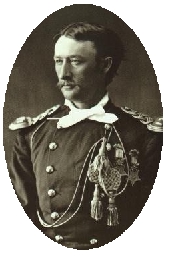
Thomas Ward Custer
The sudden darkness of death
Overwhelmed them like the breath
And smoke of a furnace fire:
By the river's bank, and between
The rocks of the ravine,
They lay in their bloody attire.
But the foemen fled in the night,
And Rain-in-the-Face, in his flight
Uplifted high in air
As a ghastly trophy, bore
The brave heart, that beat no more,
Of the White Chief with yellow hair.
Whose was the right and the wrong?
Sing it, O funeral song,
With a voice that is full of tears,
And say that our broken faith
Wrought all this ruin and scathe,
In the Year of a Hundred Years.
|
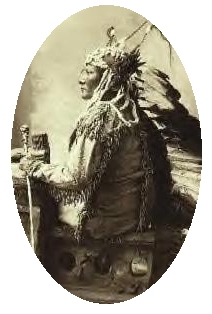 Rain-in-the-face (Itonagaju)
Even after denials by Rain-in-the-Face, the belief grew. One retired
Civil War Union general, Delevan Bates, later wrote:
Rain-in-the-face (Itonagaju)
Even after denials by Rain-in-the-Face, the belief grew. One retired
Civil War Union general, Delevan Bates, later wrote:
One hundred and sixty-three dead Indians were found in front of where Tom
and the General fell. Tom fell first and then his brother was pierced
with a dozen bullets, the last survivor of the bloody field.
Rain-in-the-Face, an Indian chief, whom Tom had arrested for some
misdemeanor on the reservation a year before was among the Indian
forces, and when Tom fell he sprang for the body, and, with scalping knife,
opened the bosom of the dying hero, tore the heart, yet quivering, from its
resting place, licked the dripping blood from the vital organ, and then
crushed it under his heel to the earth.
There is but one problem. It simply was not true. G. A. Custer's body bore only
two bullet wounds, either of which whould have been fatal. Although Tom Custer's body was brutishly
mutulated, his chest cavity was not opened. The stripping of the bodies, the unspeakable
mutulations, and theft of the mortal possessions of the dead was done by others after the battle
was over. Rain-in-the-Face shortly before his death in 1905 explained to physician Charles A Eastman:
Many lies have been told of me. Some say that I killed the Chief, and
others that I cut out the heart of his brother, because
he had caused me to be imprisoned. Why, in that fight the excitement
was so great that we scarcely recognized our nearest friends! Everything
was done like lightning. After the battle we young men were chasing horses
all over the prairie, while the old men and women plundered the bodies;
and if any mutilating was done, it was by the old men.
Dr. Eastman (1858-1939) was a Santee Sioux whose original name was Ohiyese. The name
Charles Alexander Eastman was adopted when as a youth he converted to Christianity. He was
educated at Beloit College, Knox College, and Dartmouth. He received a
medical degree at Boston University Medical School. As a physician he practiced at, among
other places, Pine Ridge and provided care to the survivors at Wounded Knee.
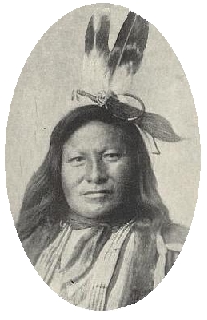
Rain-in-the-Face
There has been speculation as to why the bodies of Custer and Keogh were stripped
bare, but they were not scalped and mutilated as were the others. As to Keogh, he was
wearing a papal medal from his services with the Papal States. It has been
speculated that the presence of the medal saved Keogh. It is, however, highly unlikely
that the Indians would have recognized its significance. In stripping bodies, the
Indians were impressed by two types of strange objects found on some of the soldiers.
One was a round object made of a shiny metal which ticked. After a while, however,
the ticking stopped. One Indian, with experimentation, was able to make the
object tick again. Others threw the ticking objects away when they stopped. The
other object was a round object which had a small arrow which, when the object was
held flat, always pointed in the same direction. Some Indians speculated it was
the magic which permitted the soldiers to be able to find each other. Wallets
were found in which there were greenish colored paper with pictures. The wallets were kept
and the paper thrown away.
As to Custer, the speculation was that he was not scalped or body parts removed
out of respect. Low Dog in his account indicates that this was the reason. Low Dog's
account, given at a time when he had just returned from Canada and may have been uncertain as to
his reception, however, gives an indication of being tilted for the benefit of a
white audience. It contains repeated protestations as to the bravery of Custer and his men.
But as indicated above, Custer was probably not recognized. He was not
in uniform and his hair had been shorn. One line of thought is that
the balding Custer simply did not have enough hair to warrant scalping. In contrast, however, Dr.
Will Frackleton, after being adopted into the Crow, was told that the Indians regarded Custer as
insane and that Indians do not scalp or mulitlate the corpse of a madman. Frackleton p. 209.
There was also an opinion that Custer's body was left alone because he
was not in uniform and thought to be a civilian. Civilian status did not, however,
protect newspaper correspondent Mark Kellogg. Kellogg's body, scalped with an ear missing, swollen and bloated in
the hot sun, could only be identified by a shoe. Thus, it must be said that the reason
the two bodies were not scalped must remain one of the mysteries surrounding
Little Bighorn.
WAS CUSTER'S BODY MUTILATED?
There has been some debate of late on the
subject, it being contended that Custer may have borne some mutilation with an
arrow, which, due to its delicate nature, was not disclosed out of concern for
the feelings of Mrs. Custer. The speculation is based on an alleged comment by Edward Godfrey to Custer
historian Charles F. Bates. Godfrey's official description, however, was
that Custer had been shot in the left temple and left breast. "There were no powder marks or signs of mutilation."
In an 1892 article in Century Magazine, "Custer's Last Battle," Godfrey repeats his assertion
that Custer was not mutilated, "All the bodies, except a few, were stripped of their clothing.
According to my recollection nearly all were scalped or mutilated, but there was one
notable exception, that of General Custer, whose face and expression were natural; he
had been shot in the temple and in the left side."
Mrs. Custer was not completely innocent of the horrors that might be visited upon one captured by
Indians. In her Boots and Saddles she described a gruesome discovery while she and
her husband were on a stroll:
The body of a white man was staked out on the ground and disembowelled.
There yet remained the embers of the smouldering fire that consumed him.
If the Indians are hurried for time, and cannot stay to witness the
prolonged torture of their victim, it is their custom to pinion the
captive and place hot coals on his vitals. The horror and fright this
gave us women lasted for a time, and rendered unnecessary the continued
warnings of our husbands about walking outside the line of the pickets.
The contemporaneous newspaper reports did not spare the families of those
killed the gory details of the revenge exacted on the bodies. The Bismark
Tribune reported that some of the more obscene mutilations were visited upon
the soldiers while still living. Nor was Mrs. Custer spared the details
of what happened to other members of her family. Yet all of the newspaper accounts including those
written by those there, indicate that Custer was not mutilated. Thus, the
conclusion must be that the early reports were accurate and later reports may be
regarded as unverified.
|
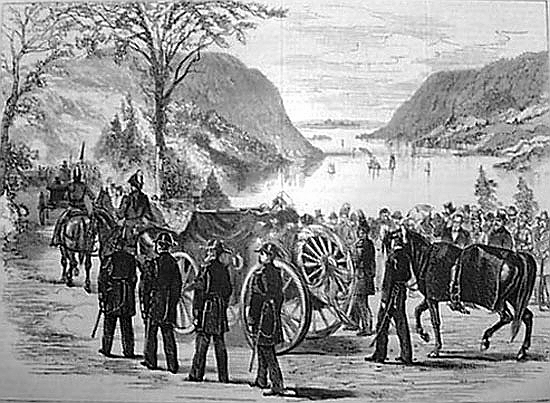
Custer's Funeral, West Point, Harper's 1877
The casket contained only a few symbolic bones. In the hardpacked Montana earth, the
bodies were placed in shallow graves. The bodies were quickly dug up by and scattered
by prairie wolves and other scavengers.
And what happened in the battle? Just as the artists provided imaginative views of the
battle, writers of the day also provided glorious accounts having little or no
relationship to reality. Thus, popular magazine writer Henry Inman wrote in
conjuntion with Wm. F. Cody, in his 1898 The Great Salt Lake Trail, Macmillan Company, New York:
In a moment, fateful incident, the Indians came swarming about that heroic
band until the very earth seemed to open and let loose the elements of
volcanic fury, or like a riot of the fiends of Erebus, blazing with the
hot sulphur of their impious dominion. Down from the hillside, up through
the valleys, that dreadful torrent of Indian cruelty and massacre poured
around the little squad to swallow it up with one grand swoop of fire.
But Custer was there at the head, like Spartacus fighting the legions about
him, tall, graceful, brave as a lion at bay, and with thunderbolts in his
hands. His brave followers formed a hollow square, and met the rush and
roar and fury of the demons. Bravely they breasted that battle shock,
bravely stood up and faced the leaden hail, nor quailed when looking into
the blazing muzzles of five thousand deadly rifles.
Brushing away the powder grimes that had settled in his face, Custer looked
over the boiling sea of fury around him, peering through the smoke for some
signs of Reno and Benteen, but seeing none. Still thinking of the aid which
must soon come, with cheering words to his men he renewed the battle,
fighting still like a Hercules and piling heaps of victims around his very
feet.
Hour after hour passed, and yet no friendly sign of Reno's coming; nothing
to be seen through the battle-smoke, except streaks of fire splitting
through the misty clouds, blood flowing in rivulets under tramping feet,
dying comrades, and Indians swarming around him, rending the air with their
demoniacal “hi-yi-yip-yah! ~ yah-hi-yah!”
The fight continued with unabated fury until late in the afternoon; men had
sunk down beside their gallant leader until there was but a handful left,
only a dozen, bleeding from many wounds and hot carbines in their stiffening
hands. ~ The day is almost done, when look! Heaven now defend him! The
charm of his life is broken, for Custer has fallen; a bullet cleaves a
pathway through his side, and as he falters another strikes his noble
breast. Like a strong oak stricken by the lightning's bolt, shivering the
mighty trunk and bending its withering branches down close to the earth,
so fell Custer; but, like the reacting branches, he rises partly up again,
and striking out like a fatally wounded giant he lays three more Indians
dead and breaks his mighty sword on the musket of a fourth; then, with
useless blade and empty pistol, falls back the victim of a dozen wounds. ~
He was the last to succumb to death, and died, too, with the glory of
accomplished duty on his conscience and the benediction of a grateful
country on his head. The place where fell these noblest of heroes is
sacred ground, and though it be the Golgotha of a nation's mistakes, it is
bathed with precious blood, rich with the gems of heroic inheritance.
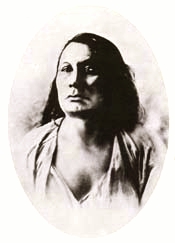 Chief Gall (Pizi)
Chief Gall (Pizi)
Chief Gall (c. 1840-1894) was a Hunkpapa chief and was generally in charge of the
fighting at Little Bighorn, leading the initial counter-attack on Reno. During
Reno's initial assault on the village, two of Gall's three wives were killed as were
three of his children. During the battles,
Chief Sitting Bull was primarily engaged in prayer and due
to age never actually participated in the fighting itself. Gall was orphaned at an
early age and received his name from his eating an animal's gall. As discussed later,
Gall accompanied Sitting Bull across the Medicine Line to Canada, but returned to
the United States in 1880 surrendering in 1881. He attended the 1886 10th-Anniversary
observance of the battle.
But what was the reality of the Battle of the Little bighorn? Reno reported:
After traveling over his trail, it was evident to me that Custer intended
to support me by moving farther down the stream and attacking the village
in flank; that he found the distance greater to ford than he anticipated;
that he did charge, but his march had taken so long, although his trail
shows that he had moved rapidly, that they were ready for him; that
Companies C and I, and perhaps part of E, crossed to the village or
attempted it; at the charge were met by a staggering fire, and that
they fell back to find a position from which to defend themselves,
but they were followed too closely by the Indians to permit time to
form any kind of a line.
I think had the regiment gone in as a body, and from the woods from which
I fought advanced upon the village, its destruction was certain. But he was
fully confident they were running away, or he would not have turned from me.
I think (after the great number of Indians that were in the village,)
that the following reasons obtain for the misfortune; His rapid marching
for two days and one night before the fight; attacking in the day-time at
12 m., and when they were on the qui vire, instead of early morning; and
lastly, his unfortunate division of the regiment into three commands.
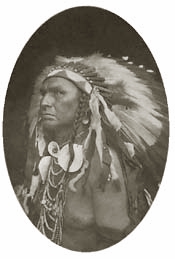 White Man Runs Him (Miastashedekaroos)
White Man Runs Him (Miastashedekaroos)
White-Man-Runs-Him, also known as Crow-Who-Talks-Gros Venre and
White-Buffalo-That-Turns-Around, was the last surviving of the Crow Scouts. He died in 1928.
It is now generally believed fron Curley's testimony and from
archeological evidence that at Cedar Creek Custer send Companies E and F under Yates down to ford the
river and Companies C, I, and L along Luce Ridge finally ending up on Calhoun
Hill, thus, dividing his forces yet again. Yates was forced to retreat up to Calhoun Hill.
Archeological evidence uncovered as a result of a fire in 1983 indicates that
a some point Custer's command was overwhelmed by the Indians fairly early in
the battle. With Custer overrun and dead, the remaining men in panic attempted to reach the cottonwood along the river and were killed on the
way, in the words of one Indian, "just like hunting buffalo." Some Indians reported that some
of the soldiers committed suicide. Thus, Wooden Leg later recalled:
[T]he white men went crazy. Instead of shooting us, they turned their guns upon themselves.
Almost before we could get to them, every one of them was dead. They killed
themselves.
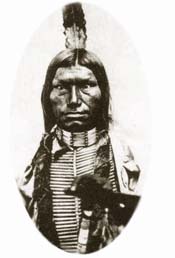 Low Dog (Xunka Kuciyedano), 1881
Low Dog (Xunka Kuciyedano), 1881
Similar reports came from Foolish Elk, Turtle Rib, and Kate Bighead, also known as Antelope Woman. However, most Indian reports were
merely that the soldiers had panicked and began to shoot wildly. Thus, in 1881 Low Dog reported:
I called to my men, "This is a good day to die: follow me." We massed our
men, and that no man should fall back, every man whipped another man's
horse and we rushed right upon them. As we rushed upon them the white
warriors dismounted to fire, but they did very poor shooting. They held
their horses reins on one arm while they were shooting, but their horses
were so frightened that they pulled the men all around, and a great many
of their shots went up in the air and did us no harm.
Low Dog was one who returned to the United States in 1881. His brother was killed in
the Battle of the Little Bighorn.
Kate Bighead's account was taken down and interpreted by
Tongue River Reservation physician Thomas Bailey Marguis (1869-1935). Following World War I,
Dr. Marguis, as a government physician, was assigned
to serve the Crow and Northern Cheyenne. As he learned their language and gained the Indians' trust,
Dr. Marguis began to take down accounts given by the Indians as to Little Bighorn. He later
operated a small museum in Hardin, Montana, and published those accounts, some as
small paperback tracts which he sold in the museum. Among them was Kate Bighead's, published in
1933 as She Watched Custer's Last Battle: Her Story, Interpreted, in 1927.
Mrs. Bighead and her family were Northern Cheyenne survivors from Washita who had taken
refuge with the Hunkpapa. Mrs. Bighead describes that following the soldiers'
attack upon the village, she rode a pony to the fringes of the battle to give courage to
Noisy Walking by singing songs. Her account continues:
In this way I could see what was happening. More and more soldiers were
getting off their horses, preferring to hide or crawl along the ground.
The ride by the river became a focal point as bands of warriors moved
toward the waiting soldiers. Hundreds of Indians had begun to crawl toward
them along crevices and gullies. Some soldiers mounted an attack off the
ridge, galloping on their horses toward a group of Cheyennes and Oglalas.
The Indians scattered to safety, and the white men dismounted again to hide
along a second ridge. As hundreds of Indians surrounded this ridge I saw
one of the soldiers point his pistol at his head and pull the trigger.
Others imitated his example, shooting sometimes themselves, sometimes each
other. When Chief Lame White Man reached the soldiers all of them were
already dead. Indians then attacked the first ridge, and again most of the
white men were already dead. The only thing remaining for the Indians to do
was pick up the abandoned guns and ammunition. As warriors walked among the
white men, they cut off the legs or feet or arms of many of the bodies.
Some of the soldiers were still living, having only been wounded, but they
were quickly killed and parts of their bodies were also severed.
Only a few soldiers were still alive and able to fight at this point, and
they joined forces at the west end of the ridge where they were surrounded
by warriors and killed. When the shooting stopped the Indians thought all
the soldiers had been killed, but seven soldiers were still alive and they
rushed out from behind their horses and started running. I could not see
what happened to these seven because of all the dust raised by the Indians
and their ponies.
Following the battle, Kate Bighead searches the battle ground and finds Noisy Walking mortally wounded. She carries him
to his mother. That night he dies. Mrs. Bighead was one of the
last survivors of the Battle of the Little Bighorn. She died in 1959.
Next page: Battle of the Little Big Horn continued.
|